Abstract
The present study focuses on the fabrication and characterization of cerium oxide (CeO2)-doped yttria-stabilized zirconia (YSZ) composite particles, aiming to enhance the durability of thermal barrier coatings (TBCs) in high-temperature applications such as gas turbines and aircraft engines. The incorporation of CeO2 into the YSZ matrix was motivated by the need to address the limitations of YSZ coatings, particularly their phase transformation and thermal degradation at temperatures exceeding 1300 °C. The synthesis of a composite with a core–shell structure, where CeO2 is doped into YSZ particles, was pursued to improve the thermal stability and reduce the thermal conductivity of the material. The fabrication process involved surface treatment of YSZ particles with HCl and NH4OH to enhance their dispersion characteristics, followed by the adsorption of CeO2 nanoparticles precipitated from Ce precursors. The study revealed a reduction in the average particle size and improved the dispersion stability of the surface-treated YSZ. Notably, base-treated YSZ exhibited increased CeO2 adsorption due to the strong interaction between Ce ions and surface hydroxyl groups. The successful formation of the YSZ@CeO2 core–shell structure was confirmed through XRD, HR-TEM, and SAED analyses. The study suggest that base-treated YSZ@CeO2 composites have the potential to extend the operating life and improve the performance of TBCs under extreme temperature conditions, which may contribute to the development of more resilient thermal barrier systems.
1. Introduction
Among ceramic materials, zirconia (ZrO2) exhibits ideal characteristics, including low thermal conductivity and a high coefficient of thermal expansion, as a topcoat material in thermal-barrier coatings (TBCs) for gas turbines. Consequently, this promoted the commercialization in TBC production for power-generation systems, such as gas turbines and aircraft engine turbines [1]. Specifically, yttria-stabilized ZrO2 (YSZ), which is ZrO2 incorporated with 7–8 wt% yttria, provides efficient heat insulation through the oxygen vacancies created when Zr4+ cations in the ZrO2 lattice are substituted by Y3+ cations to stabilize the lattice, thereby YSZ provides enhanced thermal stability [2,3]. Owing to its favorable mechanical properties, such as high fracture toughness and ionic conductivity, YSZ has been extensively commercialized in the aerospace and power generation sectors as a TBC material [4]. However, when YSZ is subjected to temperatures exceeding 1300 °C for extended periods, it undergoes a phase transformation accompanied by volumetric changes in the particles, thereby inducing internal stress within the material and increased thermal conductivity [5,6]. This manifests as structural degradation through phenomena, such as crack formation and coating delamination, ultimately compromising the integrity of TBCs [7,8]. Consequently, intensive research on the advancement of material and coating process technologies is imperative to mitigate damage and enhance the high-temperature resilience of TBCs.
Numerous studies have reported the utilization of composite powders synthesized by amalgamating YSZ with rare-earth oxides. The dissolution of rare-earth ions into the zirconia lattice is a key mechanism for enhancing the properties of YSZ coatings. The similar ionic radii of rare-earth ions to Zr4⁺ ions enable them to substitute Zr4⁺ ions in the lattice, although this substitution creates a charge imbalance due to their different valences [9]. To compensate for this imbalance, oxygen vacancies are formed within the lattice, contributing to the improvement of thermal barrier performance and ionic conductivity of YSZ coatings [10]. In particular, the incorporation of cerium oxide (CeO2), characterized by its high oxygen vacancy concentration, as a dopant into YSZ enhances its high-temperature phase stability and concurrently reduces thermal conductivity, thereby contributing to the overall performance improvement of the TBC [11,12,13].
Several methods, including co-precipitation, the homogeneous precipitation method, and spray granulation, have been explored for the preparation of YSZ composite powders coated with rare-earth oxides. Co-precipitation, a method that involves the simultaneous precipitation of multiple components from a solution by adding a precipitating agent, offers simplicity and cost effectiveness. However, it presents challenges in controlling particle size, shape, and achieving compositional uniformity [14]. The homogeneous precipitation method, similar to co-precipitation, distinguishes itself by gradually generating the precipitant within the solution rather than directly adding it, thereby promoting uniform precipitation. This approach allows for control over particle size and shape and mitigates the issue of non-uniform composition. However, it still exhibits limitations in terms of adsorption capacity and coating uniformity compared to other techniques [15]. Spray granulation, a technique that involves spraying a binder solution onto fine powders to form larger granules through particle agglomeration, provides facile control over particle size and morphology by adjusting spray conditions, binder type, and concentration. Nevertheless, it may lead to less uniform coatings and weaker bonding between YSZ and rare-earth oxides [16]. The choice of method depends on the desired properties and applications of the YSZ–rare-earth oxide composite powder, given the inherent advantages and disadvantages of each technique.
In this study, a novel manufacturing method including surface treatment and adsorption process is proposed to overcome the limitations of existing technologies and form core–shell YSZ composite powders with uniform CeO2 distribution and improved dispersibility. Core–shell structured composite oxides are advantageous for enhancing high-temperature durability because they suppress segregation and make it easy to apply a uniform coating layer to the upper coating. In addition, precise control over the microstructure is possible, allowing for tuning the optimization of TBC properties [17,18]. The YSZ@ CeO2 composite was synthesized through surface treatments using a hydrochloric acid (HCl) solution and ammonium hydroxide solution (NH4OH). The effects of these treatments on the particle size and dispersion characteristics of the YSZ surface were investigated. Following surface treatment, CeO2 nanoparticles, which precipitated from the Ce precursors, were adsorbed onto the surfaces of the treated YSZ particles. In this study, the surface properties and behavioral changes of the resultant YSZ@CeO2 composites were investigated. The observed enhanced properties suggest the potential for improving the high-temperature durability and service life of TBCs, laying a foundation for future research. Notably, the structural modification of the YSZ-CeO2 composites was achieved by implementing a physically dispersed CeO2 distribution within a core–shell architecture. This structural change signifies a promising avenue for performance enhancement in the field of thermal barrier coatings (TBCs).
2. Materials and Methods
2.1. Surface Treatment of YSZ Nanoparticles
In the initial prewashing step, 2 g of YSZ powder (8 mol% Y2O3, Hankyung, Republic of Korea) was dispersed in 200 mL of distilled water via ultrasonication. The suspension was centrifuged at 10,000 rpm for approximately 10 min to recover the powder; this process was repeated five times to ensure a thorough prewashing of the raw YSZ powder. The prewashed YSZ particles were redispersed in 200 mL of distilled water in a three-necked round-bottom flask and stirred at 300 rpm for 30 min using a mechanical stirrer. Subsequently, either 2 N NH4OH solution (28–30 wt%, Junsei, Japan) or 2 N HCl solution (35–37% concentrate, Samchun Chemical, Republic of Korea) was added. The mixture was stirred at the same speed at 80 °C for 1 h. After completing the reaction, the mixture was naturally cooled to room temperature and then washed three times with 500 mL distilled water to collect the powder.
2.2. CeO2 Decoration on YSZ Nanoparticles
The pretreated YSZ (1 g) was mixed with 0.48 wt% cerium (III) nitrate hexahydrate (Ce(NO3)3·6H2O, 99.99%, Sigma Aldrich, USA) in a three-neck round-bottom flask containing 200 mL distilled water. The mixture was stirred at 300 rpm for 1 h to disperse the powder into the solution. Subsequently, the pH of the mixture was adjusted to 10 using a NH4OH solution (28–30%, Junsei, Japan) and maintained for 16 h. After the reaction was complete, the particles in the solution were recovered by centrifugation. The recovered powder was then washed thrice in 100 mL distilled water via ultrasonication before being stored in a polypropylene bottle.
2.3. Characterization
The surface characteristics of the YSZ particles surface modified with acids and bases were evaluated by Fourier-transform infrared (FT-IR) spectroscopy (IRXross, Shimadzu, Japan). The surface charges and dispersion properties of colloidal particles were evaluated based on their zeta potentials and particle-size distributions, which were measured using dynamic light scattering (DLS, Zetasizer Lab, Malvern, UK). The crystal structures and morphologies of the modified nanoparticles were investigated via high-resolution transmission electron microscopy (HR-TEM, Tecnai G2 F30 S-Twin, FEI, USA) and X-ray diffraction (XRD, MiniFlex, Rigaku, Japan) with Cu Kα radiation (λ = 1.5418 Å). The elemental composition of the composite was determined using energy-dispersive X-ray spectroscopy (EDS, DPP-II, EDAX detector, USA).
3. Results and Discussion
Figure 1 and Figure 2 present the TEM and SEM images used to analyze the changes in the particle morphology after surface pretreatment. TEM images show that the average particle size of raw YSZ treated with acid decreases from 70 nm to 53 nm. This suggests the possibility of clear etching of the particles owing to acid treatment. A possible etching reaction of YSZ with HCl is as follows:
ZrO2 + Y2O3 + 10HCl → ZrCl4 + Y2Cl3 + 5H2O
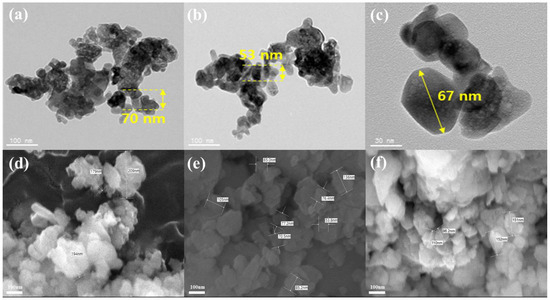
Figure 1.
TEM images of (a) raw YSZ, (b) acid-treated YSZ, and (c) base-treated YSZ. SEM images of (d) raw YSZ, (e) acid-treated YSZ, and (f) base-treated YSZ.
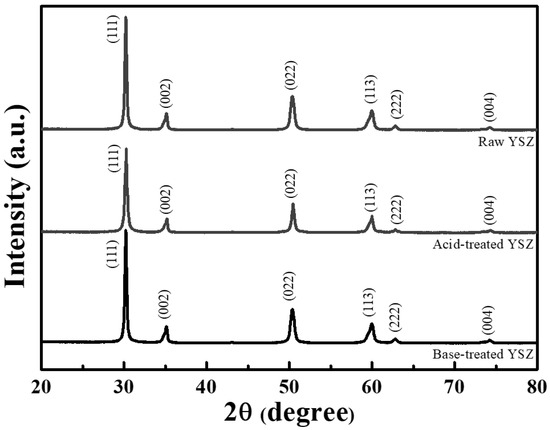
Figure 2.
XRD spectra of raw YSZ and YSZ surface treated with acid and base solutions.
When YSZ reacts with HCl, chlorides such as zirconium (IV) chloride (ZrCl4) and yttrium (III) chloride (YCl3) are formed [19]. During this reaction, the ZrO2 and yttria components are converted into chlorides and dissolved, reducing the size of the YSZ particles [20]. Thus, raw YSZ was partially or completely dissolved by HCl, leading to a reduction in particle size. In comparison, the size of the raw YSZ particles treated with the basic solution decreased after surface treatment but maintained a relatively larger size. This suggests that the reactions during the basic treatment process cause less damage to the particle surface, resulting in a minimal size reduction.
Figure 2 shows the XRD results used in analyzing the crystal phases of the particles before and after surface pretreatment. The spectra before and after surface pretreatment exhibit peaks corresponding to YSZ at 2θ of (111), (022), and (113) [21]. These diffraction patterns indicate a cubic crystal structure (JCPDS no. 77-2112), suggesting the retained crystal structure of the YSZ particles after surface treatment [22]. The peaks of the spectrum of the acid-treated YSZ particles have lower intensity than those of the raw YSZ particles. As previously confirmed through the TEM images, such reduction is attributed to the etching caused by the acid treatment, which reduces the size of the particles and affects the relative intensity of the diffraction patterns. Conversely, the spectrum of base-treated particles exhibits peak intensities similar to those of raw YSZ particles. The similar trends in the crystal patterns indicate the minimal impact of base treatment on particle loss. Thus, base treatment has less effect on both the size and crystallographic properties of the YSZ particles than with acid treatment.
Figure 3 presents a comparison of the elemental compositions and states before and after surface treatment of the YSZ nanoparticles, as analyzed through X-ray photoelectron spectroscopy (XPS). XPS analysis revealed the presence of characteristic peaks for Zr, namely Zr 5/2 and Zr 3/2 peaks, and Y, namely Y 5/2 and Y 3/2 peaks, in both the untreated and acid- or base-treated YSZ nanoparticles. This suggests the preserved fundamental chemical composition of the YSZ particles throughout surface treatment. However, an additional reduced peak is observed in the Y 3d orbital of the Y 5/2 peak for the base-treated YSZ particles. The emergence of this reduced peak suggests the excessive oxidation or etching during surface treatment, implying the reduction of Y to a lower oxidation state during surface treatment with a basic solution. Consequently, the base treatment induced changes in the chemical environment of Y.

Figure 3.
XPS spectra of raw YSZ and YSZ surface treated with acid and base.
The alterations in the properties of the YSZ nanoparticles after acid and base surface treatments was elucidated by FT-IR spectroscopy to analyze the changes in the surface functional groups. The resultant spectra, as shown in Figure 4, exhibit a broad band at approximately 625 cm−1 across all samples, indicating the Me–O stretching vibrations [23]. Such broad band suggests the formation of metal–oxide bonds between Zr and Y in YSZ and O2. Additionally, the band at wavelengths of 1637–1390 cm−1 is attributed to the asymmetric and symmetric stretching vibrations of the carboxylate (COO–) groups [24]. The clear distinction between the peaks within the 237 cm−1 range, from asymmetric COO– stretching at 1637 cm−1 to the symmetric COO– stretching at 1390 cm−1, indicates the formation of a nonidentical complex resulting from chelation with citric acid, a common component used in manufacturing commercial YSZ particles [25]. Subsequently, at 1550 cm−1, a CO– stretching mode is identified. Notably, after surface functionalization through acid or base treatment, the peak corresponding to the C–O bond at 1550 cm−1 is weakened compared with that of the raw particles. This weakening suggests the loss of particles owing to bond disruption during etching. Furthermore, the wide band at 3453 cm−1 is posited to be associated with the formed hydroxyl (OH) groups, indicating the presence of hydroxylated surfaces after surface treatment. In the acid-treated YSZ nanoparticles, the width of this band is slightly lower than that of the raw YSZ nanoparticles, which can be ascribed to the dihydroxylation–catalytic reaction between the H ions in the acid and terminal OH groups on the surface of the YSZ particles [26]. Conversely, in the base-treated YSZ nanoparticles, the width of this band greatly increased, suggesting that the OH groups bound to the terminal defects of Y or Zr on the YSZ nanoparticle surface are saturated by the hydroxide in the base.
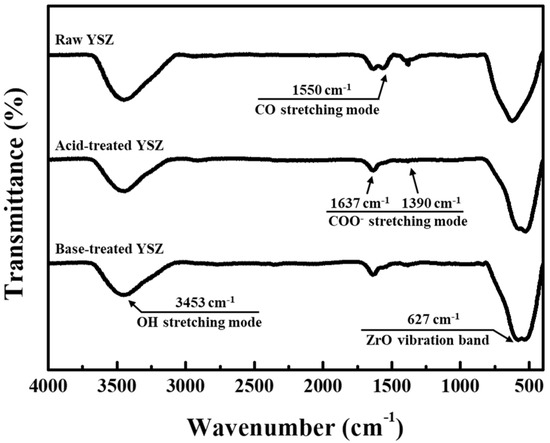
Figure 4.
FT−IR spectra of the raw YSZ and YSZ surface treated with acid and base solutions.
The dispersion stability and size reduction of YSZ nanoparticles after surface treatment with acid and base solutions were analyzed in terms of the particle-size distribution measured by DLS. The PSD and average particle size of raw YSZ, acid- and base-treated YSZ, are shown in Figure 5 and Table 1. The median particle size (D50) of the raw YSZ nanoparticles is approximately 488 nm, whereas that of the acid-treated YSZ nanoparticles slightly decreases to 420 nm. The particle-size distribution of the acid-treated YSZ nanoparticles shifts to the left from that of the raw YSZ nanoparticles, denoting a reduction in the overall particle size owing to acid treatment. Although the maximum size distribution ranges in the two graphs are similar, the minimum particle-size distribution of the acid-treated YSZ is lower, suggesting that acid treatment reduced the overall particle size. Such irregularities on the particle surface increase the interparticle attraction, leading to enhanced aggregation of particles and less uniform particle sizes. Consequently, acid treatment may form damaged particles on the surface, thereby increasing the proportion of smaller particles. Conversely, the D50 of the base-treated YSZ nanoparticles is 480 nm. The similarity in shape between the graphs of the base-treated and raw YSZ nanoparticles indicated minimal particle damage. After the base surface treatment, the graph width is reduced, owing to the introduction of negatively charged OH groups on the surface during base surface treatment. This results in increased repulsion and less aggregation among the particles, enhancing the uniformity of their distribution. The reason why the PSD value at this time was higher than the microscope images in terms of particle size is thought to be because the particles being measured did not secure sufficient dispersibility and aggregation increased.

Figure 5.
Particle-size distribution of raw YSZ and YSZ surface treated using acid and base solutions.

Table 1.
Average particle size of raw YSZ and YSZ surface treated with acid and base solution.
CeO2 nanoparticles were synthesized through the sol–gel reaction of a Ce precursor and then adsorbed onto the surface of YSZ particles, which had been treated with an acid or base solution, thereby producing a decorated morphology. TEM was used to observe the morphology, as depicted in Figure 6a–c. The XRD patterns of raw YSZ and CeO2-decorated YSZ nanoparticles were analyzed to examine the changes in their atomic and crystal structures. Additionally, the crystal structure characteristics of the nanocomposites were compared using HR-TEM and selected-area electron diffraction (SAED). The particle size and morphology of the raw YSZ nanoparticles varied, with an average size of 122 nm. The presence of ceria was determined based on the surface treatment method used. Specifically, the YSZ particles are densely packed at the center with small and unevenly distributed particles, presumed to be ceria, adsorbed on the surfaces surrounding the central particles.
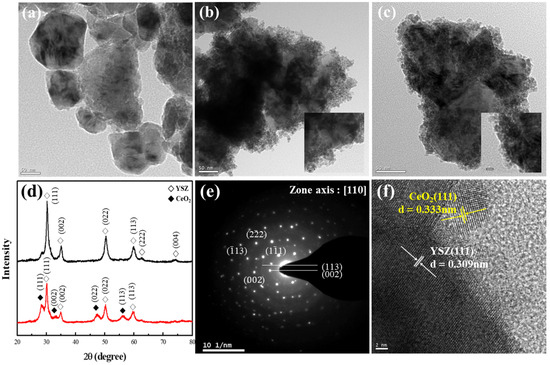
Figure 6.
TEM images of YSZ before and after surface treatment, showing the crystallography of YSZ@CeO2: (a) raw YSZ, (b) acid-treated YSZ@CeO2, and (c) base-treated YSZ@CeO2. (d) XRD spectra of YSZ and YSZ@CeO2. (e) SAED images of dot patterns, representing YSZ, and ring patterns, representing CeO2. (f) HR-TEM images of YSZ@CeO2.
Figure 6d presents the XRD patterns of the powders consisting of CeO2 surface bonded to YSZ nanoparticles that were surface treated with a base solution, thereby exhibiting reduced surface etching and enhanced dispersion stability due to increased repulsion from OH groups. The XRD pattern of the YSZ@CeO2 particles exhibits diffraction peaks at 2θ values of 28.5°, 32.9°, 47.28°, and 56.09°, corresponding to the (111), (200), (220), and (311) planes, respectively [27]. These peaks primarily correspond to the fluorite structure of CeO2 (JCPDS no. 43-1002) [28]. Such crystallographic diffraction patterns are used in determining the lattice structures of each phase through HR-TEM, as shown in Figure 6e. The crystal sizes measured from these patterns are given in Table 2. and are approximately 8.05 and 5.20 nm for YSZ and CeO2, respectively, as calculated using the Scherrer equation [26]:

Table 2.
Crystallite size of YSZ and YSZ@CeO2 nanoparticles.
In addition, the crystallographic planes were mapped and correlated with the XRD results, as shown in Figure 6f. SAED was used to identify the tetragonal phase, and the diffraction rings adjacent to these points matched the fluorite structure of CeO2 observed in the XRD results. The successful attachment of CeO2 to YSZ was confirmed through TEM interface imaging. The interfacial interaction can be elucidated by the chemical mechanism of the particles. The high charge density of Ce4⁺ ions in CeO2 nanoparticles facilitates strong electrostatic interactions with OH functional groups on the YSZ surface. These interactions promote the formation of covalent bonds between the unshared electron pairs of O atoms in the OH groups and the vacant orbitals of Ce4⁺ ions, leading to stable adsorption. Furthermore, the coordination of Ce4⁺ ions with multiple surrounding OH functional groups or OH⁻ ions in solution contributes to their enhanced stability. The successful synthesis of YSZ@CeO2 nanoparticles, consistent with this proposed chemical mechanism, was corroborated by TEM image analysis.
The distribution of the atomic composition of the synthesized YSZ@CeO2 nanoparticles was analyzed using EDS, as shown in Figure 7. Elemental distribution images revealed the regions containing Y and Zr at approximately 150 nm, whereas the Ce regions occupied a larger area at 240 nm. Consequently, the ceria-coated layer had an average thickness of approximately 45 nm and its O distribution is extensive, similar to that in the Ce region, indicating that CeO2 was decorated on the YSZ surface. Notably, a clear distinction in the Ce distribution is observed between the acid- and base-treated YSZ nanoparticles. The detailed compositional ratios are listed in Table 3.
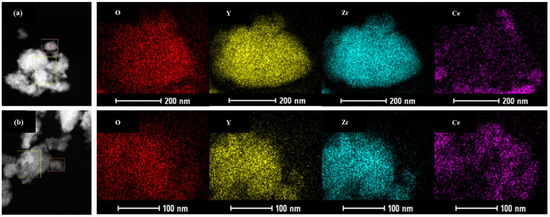
Figure 7.
(a) STEM image of acid-treated YSZ@CeO2 nanoparticles of EDS elemental mapping with separate maps shown for O, Y, Zr, and Ce and (b) base-treated YSZ@CeO2 nanoparticles of EDS elemental mapping with separate maps shown for O, Y, Zr, and Ce.

Table 3.
Chemical composition of acid-treated and base-treated YSZ@CeO2 nanoparticles.
The core components of the YSZ particles, namely Zr and Y, remained largely unchanged regardless of the surface-treatment conditions. Meanwhile, the proportion of elemental Ce in the acid-treated nanoparticles is 2.24 at%, whereas that in the base-treated composite nanoparticles is 6.37 at%. This indicates a difference of approximately 4 at% in the Ce content between the acid- and base-treated nanoparticles, suggesting an increase in the surface adsorption of Ce on the particles treated with the base solution.
Similar to the previous surface-treatment processes, an increase in the amount of Ce is accompanied by a relative increase in the number of OH functional groups. According to the FT-IR results, the increase in the OH functional groups on the YSZ surface enhances the bonding with ceria and facilitated ceria decoration on the surface. Hence, when Ce3+ ions dissolve, they are reduced to Ce4+-containing O with a strong negative charge, thereby bonding covalently with the OH functional groups on the surface of the YSZ nanoparticles. Ce4+ exists in a stable state by bonding with four O atoms, stabilizing the surrounding area, and forming a stable crystalline phase in a core–shell structure because of the energy limitations associated with growth after nucleation. The high affinity between Ce ions and OH functional groups indicates the increased Ce adsorption with the quantity of OH functional groups.
4. Conclusions
YSZ nanoparticles were surface functionalized with HCl and NH4OH and subsequently doped with precipitated ceria particles. Surface functionalization confirmed the effectiveness of the treatments applied to the YSZ particles, as exhibited by the different OH peaks. In particular, the acid-treated nanoparticle surfaces had weaker OH peaks owing to dehydration–catalysis reactions, whereas the base-treated surfaces demonstrated stronger OH peaks owing to the binding of the hydroxide contained in the base. The particle-size distribution behavior via DLS revealed the nearly identical graphs for raw and base-treated YSZ nanoparticles; however, acid treatment reduced the overall particle size and homogeneity. HR-TEM and SAED pattern analyses confirmed the successful attachment of CeO2 to the YSZ nanoparticles. However, the adsorption rates of CeO2 varied, owing to differences in the generated OH groups; the base-treated composites exhibited an adsorption rate exceeding four times that of the acid-treated composites because of the higher affinity between the OH groups and CeO2. These findings suggest that base-treated YSZ-CeO2 composites represent a more practical solution for enhancing the high-temperature durability of TBCs and establishing advanced processing technologies for TBC manufacturing.
Author Contributions
Conceptualization, methodology, validation, data curation, writing—original draft preparation, and visualization, Y.S.K.; formal analysis, investigation, Y.-S.O.; writing—review and editing, resources, and supervision, G.S.A. All authors have read and agreed to the published version of the manuscript.
Funding
This research was funded by the Korea Institute of Ceramic Engineering & Technology ceramic strategic technology development project grant number [KPP22011-0-02].
Data Availability Statement
All data used to support the findings of this study are included in this article.
Conflicts of Interest
The authors declare no conflict of interest.
References
- Zhang, W.; Shi, F.; Wang, J.; Yang, Y.; Zhao, G.; Zhao, D. Preparation and properties of a porous ZrO2/SiZrBOC ceramic matrix composite with high temperature resistance and low thermal conductivity. J. Eur. Ceram. Soc. 2024, 44, 2329–2337. [Google Scholar] [CrossRef]
- Lima, R.S. Perspectives on thermal gradients in porous ZrO2-7–8 wt.% Y2O3 (YSZ) thermal barrier coatings (TBCs) manufactured by air plasma spray (APS). Coatings 2020, 10, 812. [Google Scholar] [CrossRef]
- Cao, Y.; Li, H.; Zheng, X.; Wang, S.; Zhou, C.; Chen, S.; Yang, P.; Zhou, T.; Chen, H.; Zhang, L. Simultaneous precipitation of Zr4+ and Y3+ ions induced refinement of precursors and powders in fabrication of Zr4+ doped Y2O3 transparent ceramics. Opt. Mater. 2023, 139, 113802. [Google Scholar] [CrossRef]
- Dong, T.-S.; Kong, L.-C.; Fu, B.-G.; Li, J.-K.; Li, G.-L. Effect of CeO2 doping on high temperature oxidation resistance of YSZ TBCs. Ceram. Int. 2022, 48, 36450–36459. [Google Scholar] [CrossRef]
- Lyu, G.; Kim, I.-S.; Song, D.; Park, H.-M.; Kim, J.S.; Song, T.; Myoung, S.; Jung, Y.-G.; Zhang, J. Sintering behavior and phase transformation of YSZ-LZ composite coatings. Ceram. Int. 2020, 46, 1307–1313. [Google Scholar] [CrossRef]
- Roncallo, G.; Barbareschi, E.; Cacciamani, G.; Vacchieri, E. Effect of cooling rate on phase transformation in 6–8 wt% YSZ APS TBCs. Surf. Coat. Technol. 2021, 412, 127071. [Google Scholar] [CrossRef]
- Lehmann, H.; Pitzer, D.; Pracht, G.; Vassen, R.; Stöver, D. Thermal conductivity and thermal expansion coefficients of the lanthanum rare-earth-element zirconate system. J. Am. Ceram. Soc. 2003, 86, 1338–1344. [Google Scholar] [CrossRef]
- Zhu, X.; Huang, Y.; Zheng, W.; Zhang, J.; Lin, C.; Schwalb, C.; Zeng, Y. Crystallinity, stresses, and cracks of YSZ coatings characterized by SEM–EBSD–Raman spectroscopy. J. Therm. Spray Technol. 2020, 29, 995–1001. [Google Scholar] [CrossRef]
- Jiang, S.; Huang, X.; He, Z.; Buyers, A. Phase transformation and lattice parameter changes of non-trivalent rare earth-doped YSZ as a function of temperature. J. Mater. Eng. Perform. 2018, 27, 2263–2270. [Google Scholar] [CrossRef]
- Chen, D.; Wang, Q.; Liu, Y.; Ning, X. Microstructure, thermal characteristics, and thermal cycling behavior of the ternary rare earth oxides (La2O3, Gd2O3, and Yb2O3) co-doped YSZ coatings. Surf. Coat. Technol. 2020, 403, 126387. [Google Scholar] [CrossRef]
- Wei, X.; Hou, G.; An, Y.; Yang, P.; Zhao, X.; Zhou, H.; Chen, J. Effect of doping CeO2 and Sc2O3 on structure, thermal properties and sintering resistance of YSZ. Ceram. Int. 2021, 47, 6875–6883. [Google Scholar] [CrossRef]
- Chernyshev, A.P. Oxygen vacancy concentration in nanoobjects of CeO2− δ: Effects of characteristic size, morphology, and temperature. Mater. Chem. Phys. 2022, 282, 125979. [Google Scholar] [CrossRef]
- Islam, A.; Sharma, A.; Singh, P.; Pandit, N.; Keshri, A.K. Plasma-sprayed CeO2 overlay on YSZ thermal barrier coating: Solution for resisting molten CMAS infiltration. Ceram. Int. 2022, 48, 14587–14595. [Google Scholar] [CrossRef]
- Sato, K.; Okamoto, G.; Naito, M.; Abe, H. NiO/YSZ nanocomposite particles synthesized via co-precipitation method for electrochemically active Ni/YSZ anode. J. Power Sources 2009, 193, 185–188. [Google Scholar] [CrossRef]
- Xin, X.; Lü, Z.; Ding, Z.; Huang, X.; Liu, Z.; Sha, X.; Zhang, Y.; Su, W. Synthesis and characteristics of nanocrystalline YSZ by homogeneous precipitation and its electrical properties. J. Alloys Compd. 2006, 425, 69–75. [Google Scholar] [CrossRef]
- Raghupathy, B.P.C.; Binner, J.G.P. Spray granulation of nanometric zirconia particles. J. Am. Ceram. Soc. 2011, 94, 42–48. [Google Scholar] [CrossRef]
- Li, Q.; Zhang, N.; Gao, Y.; Qing, Y.; Zhu, Y.; Yang, K.; Zhu, J.; Wang, H.; Ma, Z.; Gao, L.; et al. Effect of the core-shell structure powders on the microstructure and thermal conduction property of YSZ/Cu composite coatings. Surf. Coat. Technol. 2021, 424, 127658. [Google Scholar] [CrossRef]
- Xiong, L.; Zheng, H.; Yu, P.; Li, G.; Chen, Z.; Zhang, B. Laser-clad YSZ@Ni (core–shell nanoparticle) composites coatings. Ceram. Int. 2015, 41, 13850–13854. [Google Scholar] [CrossRef]
- Prajzler, V.; Maca, K.; Todd, R. Residual chlorine prevents full densification of flash sintered yttria-stabilized zirconia ceramics. J. Eur. Ceram. Soc. 2024, 44, 6660–6667. [Google Scholar] [CrossRef]
- Guo, F.; Javed, A.; Shapiro, I.P.; Xiao, P. Effect of HCl concentration on the sintering behavior of 8 mol% Y2O3 stabilized ZrO2 deposits produced by electrophoretic deposition (EPD). J. Eur. Ceram. Soc. 2012, 32, 211–218. [Google Scholar] [CrossRef]
- Khollam, Y.B.; Deshpande, A.S.; Patil, A.J.; Potdar, H.S.; Deshpande, S.B.; Date, S.K. Synthesis of yttria stabilized cubic zirconia (YSZ) powders by microwave-hydrothermal route. Mater. Chem. Phys. 2001, 71, 235–241. [Google Scholar] [CrossRef]
- Mao, X.; Shan, H.; Song, J.; Bai, Y.; Yu, J.; Ding, B. Brittle-flexible-brittle transition in nanocrystalline zirconia nanofibrous membranes. CrystEngComm 2016, 18, 1139–1146. [Google Scholar] [CrossRef]
- Tõnsuaadu, K.; Zalga, A.; Beganskiene, A.; Kareiva, A. Thermoanalytical study of the YSZ precursors prepared by aqueous sol–gel synthesis route. J. Therm. Anal. Calorim. 2012, 110, 77–83. [Google Scholar] [CrossRef]
- Alhareb, A.O.; Akil, H.B.M.; Ahmad, Z.A.B. Poly(methyl methacrylate) denture base composites enhancement by various combinations of nitrile butadiene rubber/treated ceramic fillers. J. Thermoplast. Compos. Mater. 2017, 30, 1069–1090. [Google Scholar] [CrossRef]
- Sinaga, P.; Bae, S.-H. Effects of di-ammonium citrate: Polyvinylpyrrolidone as a complexion dispersants on 3Y-TZP slurries and sintered body properties. J. Korean Ceram. Soc. 2022, 59, 506–513. [Google Scholar] [CrossRef]
- Monshi, A.; Foroughi, M.R.; Monshi, M.R. Modified Scherrer equation to estimate more accurately nano-crystallite size using XRD. World J. Nano Sci. Eng. 2012, 2, 154–160. [Google Scholar] [CrossRef]
- Farahmandjou, M.; Zarinkamar, M.; Firoozabadi, T.P. Synthesis of Cerium Oxide (CeO2) nanoparticles using simple CO-precipitation method. Revista Mexicana de Física 2016, 62, 496–499. [Google Scholar]
- Li, K.; Zhao, P. Synthesis of single-crystalline Ce (CO3)(OH) with novel dendrite morphology and their thermal conversion to CeO2. Mater. Res. Bull. 2010, 45, 243–246. [Google Scholar] [CrossRef]
Disclaimer/Publisher’s Note: The statements, opinions and data contained in all publications are solely those of the individual author(s) and contributor(s) and not of MDPI and/or the editor(s). MDPI and/or the editor(s) disclaim responsibility for any injury to people or property resulting from any ideas, methods, instructions or products referred to in the content. |
© 2024 by the authors. Licensee MDPI, Basel, Switzerland. This article is an open access article distributed under the terms and conditions of the Creative Commons Attribution (CC BY) license (https://creativecommons.org/licenses/by/4.0/).